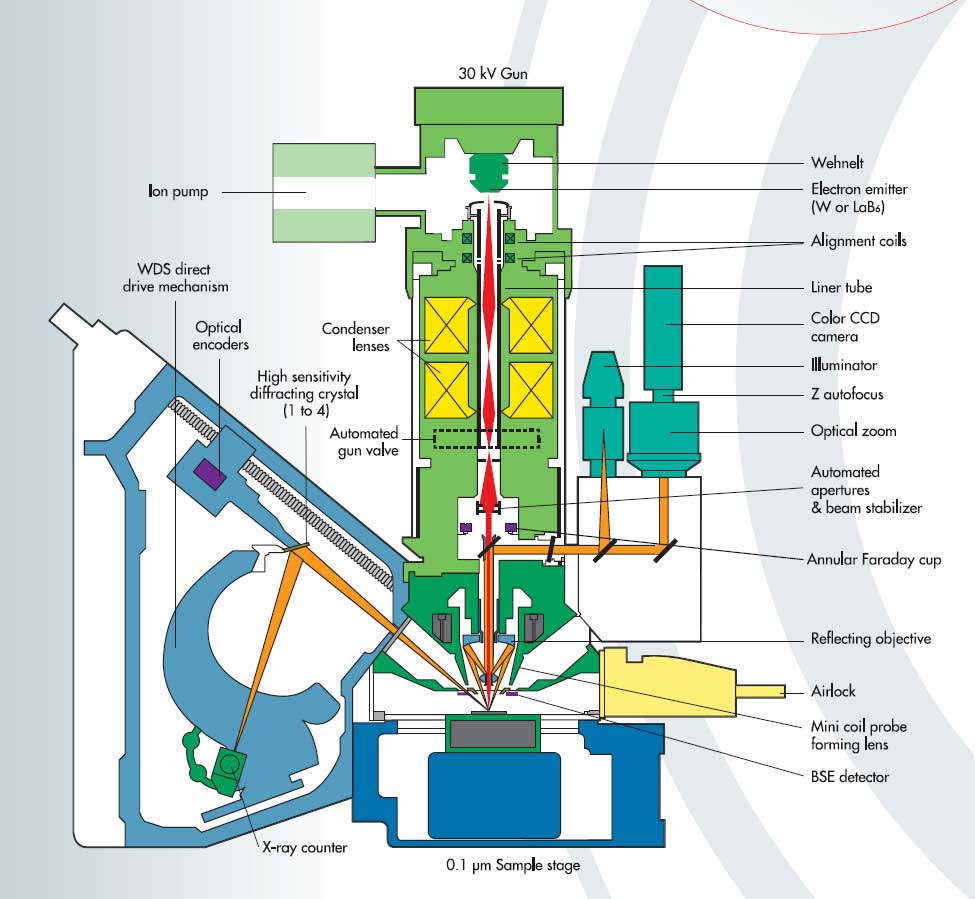Electron Probe Micro Analyser (EPMA) Facility
 NCESS-CAMECA SXFive-Tactis is equipped with five wave length dispersive spectrometers, BSE detectors, SE detectors, cathodoluminescence and sophisticated visible light optics. The self-biased electron gun of the instrument has the provision for both W and LaB6 filaments. The instrument is configured in such a way so that operation as well as basic imaging and data processing are made easy for having intuitive touch screen interface. In expert mode, the interface is designed to have benefit from a full complement of different tool parameters and software options. The system involves a high degree of automation with the capacity of prolonged unattended analytical schedules with high analytical precision, accuracy and reproducibility with minimum down-time, high quality imaging at high spatial resolution including multi-element x-ray mapping. Vertical WDSs are compatible to have suitable combinations in high sensitivity diffracting crystals (e.g. LTAP, LPC1, LLIF and LPET) as well as six diffracting crystals such as TAP, LIF, PET, PC0, PC3 and PC2. Another advantage of this instrument is that it is equipped with a fully integrated Electron Dispersive Spectrometer hypermapping module making data processing and analysis faster and easier. SX- Five with LaB6 Column: Accelerating Voltage: 15KV and 20 KV; Beam Current: 20 uA onwards; Beam Stability: +-0.5% per hour @ 20kV, 20nA.
NCESS-CAMECA SXFive-Tactis is equipped with five wave length dispersive spectrometers, BSE detectors, SE detectors, cathodoluminescence and sophisticated visible light optics. The self-biased electron gun of the instrument has the provision for both W and LaB6 filaments. The instrument is configured in such a way so that operation as well as basic imaging and data processing are made easy for having intuitive touch screen interface. In expert mode, the interface is designed to have benefit from a full complement of different tool parameters and software options. The system involves a high degree of automation with the capacity of prolonged unattended analytical schedules with high analytical precision, accuracy and reproducibility with minimum down-time, high quality imaging at high spatial resolution including multi-element x-ray mapping. Vertical WDSs are compatible to have suitable combinations in high sensitivity diffracting crystals (e.g. LTAP, LPC1, LLIF and LPET) as well as six diffracting crystals such as TAP, LIF, PET, PC0, PC3 and PC2. Another advantage of this instrument is that it is equipped with a fully integrated Electron Dispersive Spectrometer hypermapping module making data processing and analysis faster and easier. SX- Five with LaB6 Column: Accelerating Voltage: 15KV and 20 KV; Beam Current: 20 uA onwards; Beam Stability: +-0.5% per hour @ 20kV, 20nA.
Capabilities
|
Cameca Silicate Std (Alamandine) |
sample |
Cameca Sulphide Std (Pyrite) |
sample |
Uranium Oxide Std |
sample |
|||
|
SiO2 |
37.87 |
37.51 |
S |
53.06 |
52.86 |
Al2O3 |
0.29 |
0.07 |
|
TiO2 |
0.07 |
0.04 |
Fe |
46.51 |
45.89 |
UO2 |
89 |
89.28 |
|
Al2O3 |
21.36 |
21.16 |
Co |
0.5 |
0.35 |
SiO2 |
2.3 |
7.23 |
|
Cr2O3 |
0.0 |
0.03 |
Ni |
0.01 |
0.01 |
ZrO2 |
1.09 |
0.3 |
|
FeO |
34.6 |
30.77 |
Cu |
0.02 |
0.06 |
TiO2 |
1.11 |
0 |
|
MnO |
0.37 |
1.64 |
Zn |
0.01 |
0 |
Gd2O3 |
0.27 |
0.89 |
|
MgO |
2.34 |
9.41 |
As |
0.02 |
0.04 |
PbO |
2.0 |
1 |
|
CaO |
4.34 |
0.65 |
- |
- |
CaO |
1.88 |
0.04 |
|
|
Na2O |
0.10 |
0.0 |
- |
- |
Y2O3 |
0.61 |
0.24 |
|
|
K2O |
0.0 |
0.0 |
- |
- |
La2O3 |
0.18 |
0.14 |
|
|
ZnO |
0.12 |
0.12 |
- |
- |
Ce2O3 |
1.21 |
0.63 |
|
|
P2O5 |
0.06 |
0.01 |
- |
- |
Nd2O3 |
0.86 |
0.49 |
|
|
Total |
101.23 |
101.34 |
99.669 |
99.21 |
Total |
100.8 |
100.31 |
 U-Th-Total Pb Chemical dating: Calibration Set up: 20 kV–20 nA, Quantification Set Up: 20 kV–200 nA. Following X-ray lines are used for major, trace and REE concentration as well as age determination for Monazite, viz., P–Ka, Ca–Ka, Si–Ka, Fe–Ka, Al–Ka, Y–La, La–La, Ce–La, Pr–Lb, Nd–Lb, Sm–Lb, Gd–Lb, Er–La, Eu–La, Dy–Lb, Ho–Lb, Pb–Ma, Th–Ma and U–Mb. Detailed analytical protocol is given in “Chemical dating of monazite: Testing of analytical protocol for U–Th–total Pb using CAMECA SXFive tactis EPMA at the National Centre for Earth Science Studies, Thiruvananthapuram, India,” by Sorcar et al., J. Earth Syst. Sci. (2021)130:234 (https://doi.org/10.1007/s12040-021-01738-4).
U-Th-Total Pb Chemical dating: Calibration Set up: 20 kV–20 nA, Quantification Set Up: 20 kV–200 nA. Following X-ray lines are used for major, trace and REE concentration as well as age determination for Monazite, viz., P–Ka, Ca–Ka, Si–Ka, Fe–Ka, Al–Ka, Y–La, La–La, Ce–La, Pr–Lb, Nd–Lb, Sm–Lb, Gd–Lb, Er–La, Eu–La, Dy–Lb, Ho–Lb, Pb–Ma, Th–Ma and U–Mb. Detailed analytical protocol is given in “Chemical dating of monazite: Testing of analytical protocol for U–Th–total Pb using CAMECA SXFive tactis EPMA at the National Centre for Earth Science Studies, Thiruvananthapuram, India,” by Sorcar et al., J. Earth Syst. Sci. (2021)130:234 (https://doi.org/10.1007/s12040-021-01738-4).
Contact
Dr. Sneha Mukherjee
Scientist-In-Charge
T: 0471-2511612
E: epmalab[at]ncess[dot]gov[dot]in

